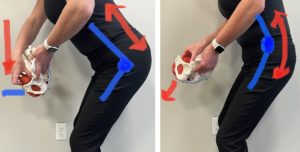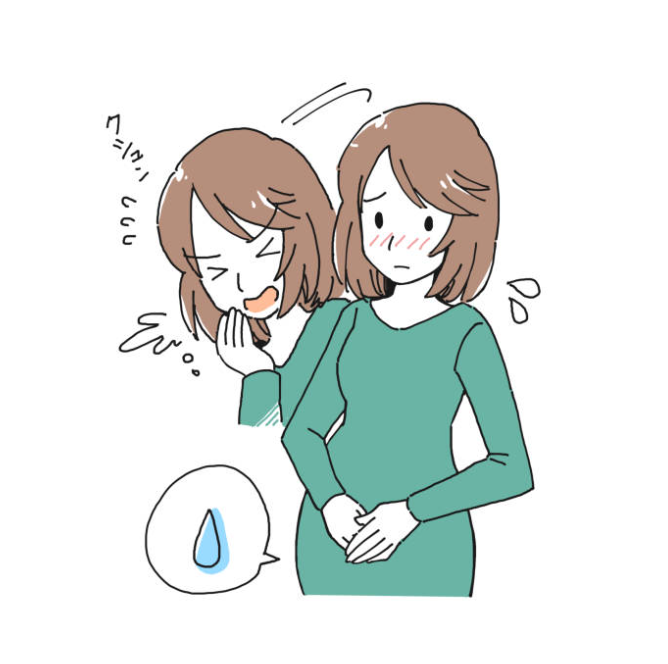When there is so much illness going around, it feels inevitable to cough and sneeze at some point. Being sick is scary if you don’t trust your bladder – talk about adding insult to injury! Coughing and sneezing puts a lot of load on the pelvic floor and when it happens repeatedly, incontinence can occur even for those who rarely have issues. There are lots of strategies that can reduce the chance of leaking while coughing or sneezing. Here are a few…
-
-
- Bend in a hip hinge rather than a rounded/folded position when you cough. This moves the bladder and pelvic floor in line with the pubic bone so there is extra support during the burst of downward pressure. It also puts your glute muscles into a more helpful length compared to a tucked bum. Note the long straight back in the first photo compared to the ribs down/folded position in the second photo. The bladder motion will be stopped by the pubic bone when it is tipped forward as shown. In the second photo, there is only soft tissue under the bladder which may allow more bladder descent.
-
Correct Position: “Hip Hinge” Incorrect Position: Rounded/Tucked

-
-
- This position works in side lying as well when you are stuck in bed. When you are going to cough, roll onto your side but lengthen your torso and bend at the hips rather than waist (like “Correct” photo) to create the hip hinge with ribs lengthened away from the pelvis. Curled into a ball/fetal position is not protective for your pelvic floor.
- Keep ribs tall during this position. Don’t tuck over your ribs forward and down as you cough.
- Don’t be afraid to breathe deep into your pelvis. Air movement in a downward direction expands your pelvic floor muscles, which then allow them to reflexively pull back up when it’s time to kick in during your cough. If you feel a cough coming on, breathe deeply just prior to coughing. You can add a kegel squeeze a split second before you cough/sneeze out.
- To prevent germ spread you are likely coughing into your elbow. Bring your elbow to your face when you cough rather than fold yourself towards your hand/elbow.
- Sit before you cough to add a bit more support to your pelvic floor.
-
Protecting your pelvic floor in this manner is good for all women, especially those with pelvic organ prolapse or incontinence. If you have lots of pelvic dysfunction, you might need a bit more individualized coaching to feel successful.
Speaking of being sick:
Don’t blow your nose while sitting on the toilet!
-
-
- When you are on the toilet, the pelvic floor should be relaxed to trigger the bladder to empty. When you blow your nose or cough, your pelvic floor should be active. This causes confusion!
- Looking for more information on pelvic floor health:
- Check out Core Exercise Solutions with PT Sarah Duvall. She has lots of Youtube videos on pelvic floor health and exercises
-

